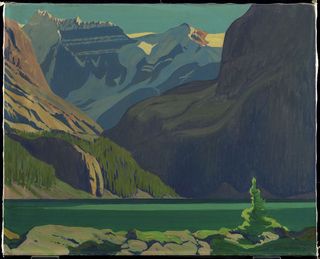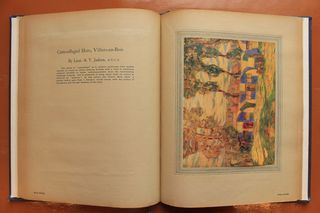
[J. E. H. MacDonald, 'Lake O'Hara', 1929, oil on canvas, 53.6 x 66.5 cm, The Thomson Collection, Copyright Art Gallery of Ontario. Currently displayed as part of 'Painting Canada: Tom Thomson and the Group of Seven'', Dulwich Picture Gallery]
On Saturday I had time to pop over to the Dulwich Picture Gallery and view the recently opened, 'Painting Canada' exhibition. Subtitled, 'Tom Thomson and the Group of Seven', the exhibition displays work from a group of artists who are credited with conceiving how to depict the uniqueness of the Canadian landscape. Wilderness is very much the focus of the exhibition and the works on display evoke both the majesty of the scenes depicted and the facination of this group of men with Canada's wild spaces.
While this wilderness is a dominant theme in the group's work they were prolific and covered many subjects, from portraits, to rural landscapes and even attempting to capture the modernist beauty of the aircraft after it arrived in Canada. The Group of Seven travelled far and wide, covering a broad span of Canada in their work, and some members also produced art in Europe, notably during the First World War.

[Lieut. A. Y. Jackson, "Camouflaged Huts, Villers-au-Bois" in, Art and War: Canadian War Memorials (1919), London: Canadian War Records Office]
In fact, I remembered during the exhibition a collection item from the Canadian War Memorial Commission which contained contributions from some of the Group. (Lieutenant) A. Y. Jackson and (Captain) F. H. Varley were both involved in the war and produced art about it. The publication Art and War: Canadian War Memorials (1919, London: Canadian War Records Office; BL Shelfmark: J/7859.i.15) was produced, "to form a record of Canada's part in the Great War and a memorial to those Canadians who have made the Great Sacrifice" and Jackson and Varley contributed four works to it.
The Group of Seven had a significant impact upon the imagination of Canada and, as 'Painting Canada' shows, continue to today. If you are interested to know more our collections hold various materials relating to Tom Thomson and the Group of Seven, including notable items such as, Art and War. There are also useful reference works such as, Housser, F. B. (1974), A Canadian Art Movement: the story of the Group of Seven, Toronto: Macmillan Co. (Shelfmark: X.429/10637); Murray, J. (1994), Tom Thomson: the Last Spring, Toronto: Dundurn Press (Shelfmark: q95/02542 DSC); and, Town, H. and Silcox, D. (1982), Tom Thomson: the Silence and the Storm, Toronto: McClelland and Stewart (Shelfmark: L.42/3735).
[PJH]